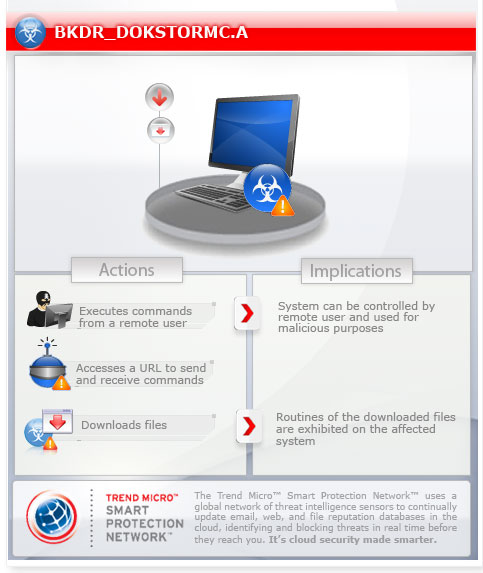BKDR_DOKSTORMC.A
W32/Injector.UPJ!tr (Fortinet), Backdoor.Win32.Dokstormac (Ikarus), Backdoor:Win32/Dokstormac.A (Microsoft), a variant of Win32/Injector.UPJ trojan (NOD32)
Windows 2000, Windows XP, Windows Server 2003


Threat Type: Backdoor
Destructiveness: No
Encrypted: Yes
In the wild: Yes
OVERVIEW
Also known as Arcom RAT (remote access tool), this backdoor arrives as a downloaded file from a fake tsunami warning video.
To get a one-glance comprehensive view of the behavior of this Backdoor, refer to the Threat Diagram shown below.

For the related story, you may read the blog post Tsunami Warning Leads to Arcom RAT
This backdoor arrives on a system as a file dropped by other malware or as a file downloaded unknowingly by users when visiting malicious sites.
It executes commands from a remote malicious user, effectively compromising the affected system.
As of this writing, the said sites are inaccessible.
TECHNICAL DETAILS
Arrival Details
This backdoor arrives on a system as a file dropped by other malware or as a file downloaded unknowingly by users when visiting malicious sites.
Installation
This backdoor drops the following file(s)/component(s):
- %Application Data%\Imvu\asl.avf
- %Application Data%\Imvu\logs\{Date of Execution}.arl
(Note: %Application Data% is the current user's Application Data folder, which is usually C:\Documents and Settings\{user name}\Application Data on Windows 2000, XP, and Server 2003, or C:\Users\{user name}\AppData\Roaming on Windows Vista and 7.)
It drops the following copies of itself into the affected system:
- %Application Data%\Imvu\Imvu.exe
(Note: %Application Data% is the current user's Application Data folder, which is usually C:\Documents and Settings\{user name}\Application Data on Windows 2000, XP, and Server 2003, or C:\Users\{user name}\AppData\Roaming on Windows Vista and 7.)
It creates the following folders:
- %Application Data%\Imvu
- %Application Data%\Imvu\logs
- %Application Data%\Imvu\IML
(Note: %Application Data% is the current user's Application Data folder, which is usually C:\Documents and Settings\{user name}\Application Data on Windows 2000, XP, and Server 2003, or C:\Users\{user name}\AppData\Roaming on Windows Vista and 7.)
It adds the following mutexes to ensure that only one of its copies runs at any one time:
- qawsed
- ujyhtg
- rftgyh
- yhujik
It injects itself into the following processes as part of its memory residency routine:
- iexplore.exe
- notepad.exe
Autostart Technique
This backdoor adds the following registry entries to enable its automatic execution at every system startup:
HKEY_CURRENT_USER\Software\Microsoft\
Windows\CurrentVersion\Run
Skype = "%Application Data%\Imvu\Imvu.exe"
Other System Modifications
This backdoor adds the following registry entries as part of its installation routine:
HKEY_CURRENT_USER\Software\Skype
ID = "{random values}"
HKEY_CURRENT_USER\Software\Skype
PX = "{random number}"
Backdoor Routine
This backdoor opens the following port(s) where it listens for remote commands:
- TCP Port 8888
It executes the following commands from a remote malicious user:
- Check for internet connection
- Visit a website
- Download other files
- Execute remote shell
- List open processes
- Terminate processes
- Create processes
- Shutdown computer
- Copy file
- Delete file
- Execute file
- Access TeamViewer if found
- Get Logical Drives information
- Delete registry keys
- Log keystrokes
- End backdoor connection
It connects to the following URL(s) to send and receive commands from a remote malicious user:
- {BLOCKED}s117.no-ip.org:1888
Download Routine
This backdoor connects to the following URL(s) to download its component file(s):
- www.{BLOCKED}e.com/file.avf
As of this writing, the said sites are inaccessible.
SOLUTION
Step 1
Before doing any scans, Windows XP, Windows Vista, and Windows 7 users must disable System Restore to allow full scanning of their computers.
Step 2
Restart in Safe Mode
Step 3
Search and delete these components
- %Application Data%\Imvu\asl.avf
- %Application Data%\Imvu\logs\{Date of Execution}.arl
Step 4
Search and delete these folders
- %Application Data%\Imvu
- %Application Data%\Imvu\logs
- %Application Data%\Imvu\IML
Step 5
Delete this registry value
Important: Editing the Windows Registry incorrectly can lead to irreversible system malfunction. Please do this step only if you know how or you can ask assistance from your system administrator. Else, check this Microsoft article first before modifying your computer's registry.
- In HKEY_CURRENT_USER\Software\Microsoft\Windows\CurrentVersion\Run
- Skype = "%Application Data%\Imvu\Imvu.exe"
- Skype = "%Application Data%\Imvu\Imvu.exe"
- In HKEY_CURRENT_USER\Software\Skype
- ID = "{random values}"
- ID = "{random values}"
- In HKEY_CURRENT_USER\Software\Skype
- PX = "{random number}"
- PX = "{random number}"
Step 6
Restart in normal mode and scan your computer with your Trend Micro product for files detected as BKDR_DOKSTORMC.A. If the detected files have already been cleaned, deleted, or quarantined by your Trend Micro product, no further step is required. You may opt to simply delete the quarantined files. Please check this Knowledge Base page for more information.
Did this description help? Tell us how we did.

